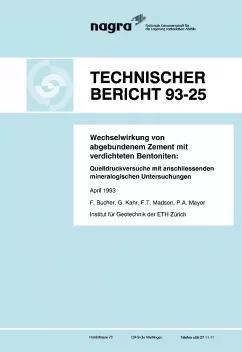
Technischer Bericht NTB 93-25
Wechselwirkung von abgebundenem Zement mit verdichteten Bentoniten: Quelldruckversuche mit anschliessenden mineralogischen Untersuchungen
Mixtures of the two bentonites MX-80 and Montigel with up to 20 % hydrated cement and synthetic portlandite were left to swell in swelling pressure apparatus for 4 to 16 weeks at ambient temperature and at 50°C. These experiments showed that the addition of cement, be it Portland cement (PC) or sulphate-resistant cement (Sulfacem), to the bentonite resulted in a significant increase in swelling pressures compared with the swelling pressures of pure bentonites. The pure hydrated cements have a very low swelling pressure. Changing the water/cement ratio from 0.2 to 0.4 and increasing the temperature from ambient to 50°C had no significant influence on swelling pressure values. Experiments which subsequently allowed swelling deformation to take place showed that the swelling capacity of the cement-bentonite samples was reduced compared with that of pure bentonites.
Following completion of the experiments and removal from the apparatus, the samples appeared to be relatively hard and to have a low swelling capability. Radiographic investigations of these materials did not reveal any formation of new crystalline phases or marked changes in the peak spectrum of the clay minerals. Thermal analysis, coupled with analysis of generated gases, did not indicate any marked thermal reactions. What was noticeable in the thermal analysis was that with longer test times in the swelling pressure apparatus the degradation of the portlandite was no longer visible. This was confirmed by the fact that the portlandite peak disappeared in the diffractometer curves. The cation exchange capacity of the swelling pressure samples showed a slight increase and the exchangeable ions were dominated by calcium.
Presumably the smectite particles of the bentonites and the cement hydrates are cemented by calcium aluminate hydrates; this has been observed in investigations with transmission electron microscopy and analytical transmission electron microscopy (ATEM).
The observed reactions of hydrated cements with the bentonites could, in principle, have a negative effect on a repository sealing concept where there is the possibility for interactions between bentonite and hydrated cement/concrete. However, it still remains to be clarified to what extent the experimental results, which were strongly affected by the boundary conditions applied when adding cement, can be applied to real conditions where bentonite is in contact with hydrated cement/concrete.
